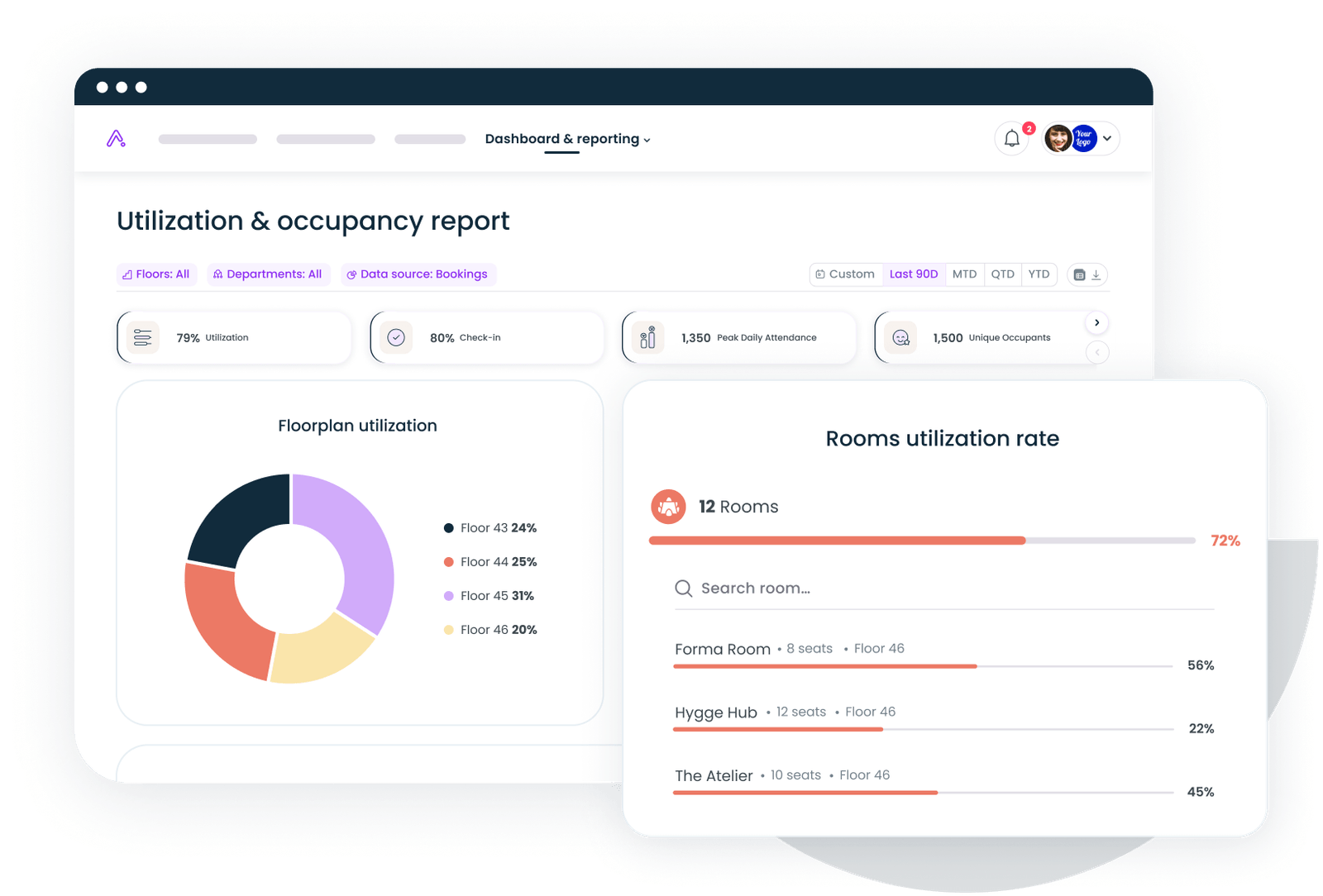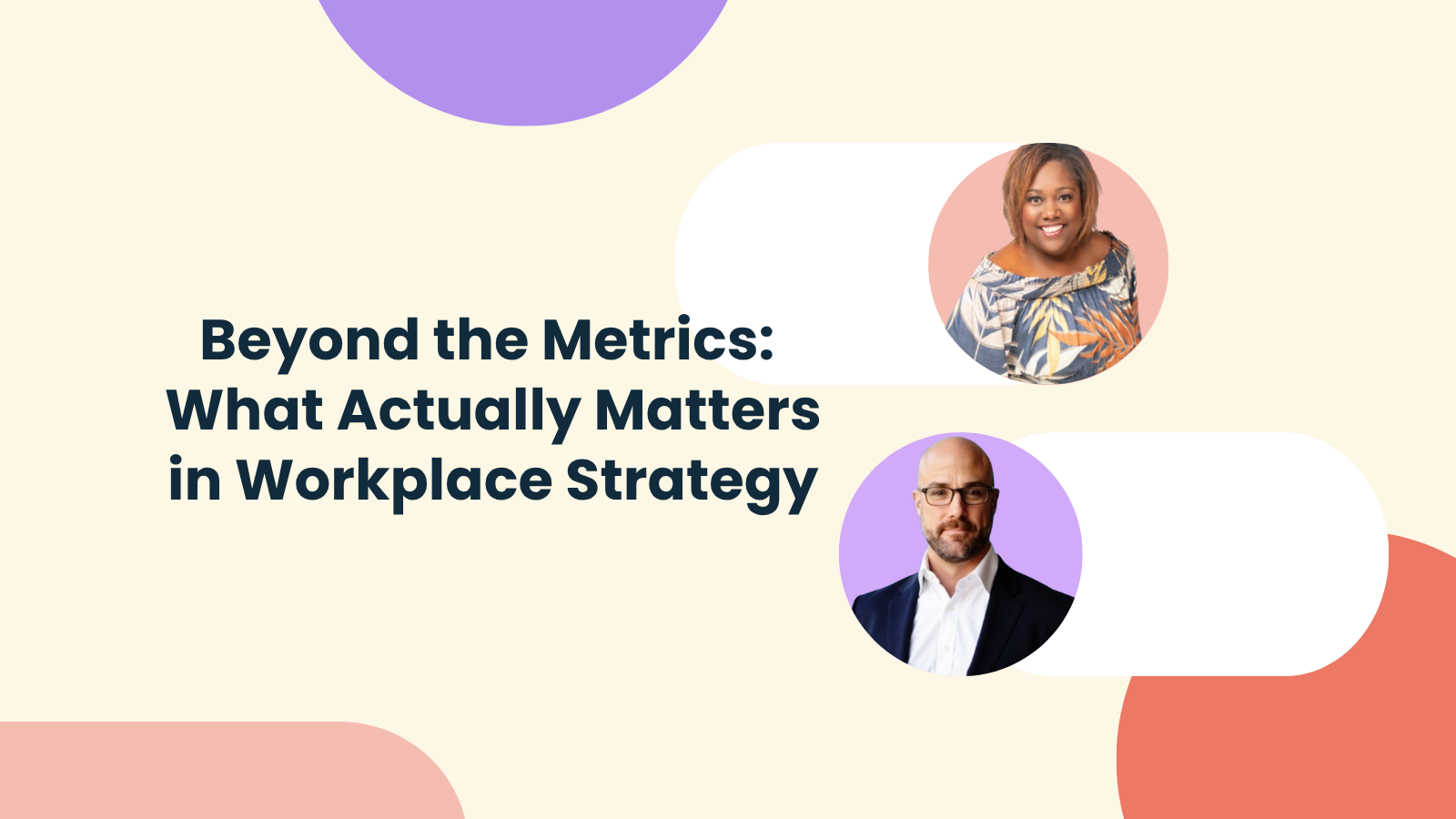Workplace optimization uses data and strategic planning to make your physical office spaces work harder for your team. It boosts employee performance, reduces operational costs, and supports how people work. With global employee engagement at just 21% and workplace utilization hovering around 40%, getting this right has never been more critical.
Workplace leaders today face a practical challenge: how to create office spaces that people actually want to use. The answer is workplace optimization: the strategic approach to designing, managing, and continuously improving your physical work environments based on real data and employee needs.
Understanding workplace optimization
Workplace optimization is a set of strategies that improve how your office spaces work. It's about using data to make smarter decisions about your real estate, space utilization, and the employee experience.
Think of your office as a product you iterate on. You collect data on how people use the space, identify what's working, then make changes to improve performance. The goal is to create environments that support employee productivity and organizational efficiency while decreasing operational costs.
According to McKinsey research on workplace practices, 68% of employees now work in-person at least four days per week, up from 34% in 2023. But the way people use offices has shifted: they're collaborating, meeting clients, and using the office for activities that genuinely benefit from physical presence.
Workplace vs workforce optimization: What's the difference?
Workforce optimization focuses on enhancing employee and organizational efficiency through the use of scheduling software, performance management tools, attendance software, and engagement strategies. Think contact center software, SAP Workforce Management, or Oracle Workforce Management that help businesses optimize staffing levels, reduce overtime expenses, and improve customer service delivery through WFO software, text analytics, and speech analytics.
Workplace optimization targets your physical office spaces, including space utilization, office layout, desk hoteling, meeting room scheduling, and creating work environments that enhance the employee experience. The focus is on real estate strategy and how people interact with physical spaces, whether a coworking space or company headquarters.
Both aim to streamline operations and lower operational costs, but workplace optimization is about your buildings and physical resources, not scheduling systems or task tracking that manages employee availability and workforce planning.
Why workplace optimization matters now
According to Gallup's 2025 State of the Global Workplace report, global employee engagement declined to 21% in 2024, resulting in an estimated $438 billion in annual lost productivity for the global economy.
Most organizations utilize only 25-30% of their office space daily, yet they're locked into long-term leases. You're paying for unused space while engagement and employee satisfaction decline.
Organizations excelling in data-driven decision-making are more productive and profitable. According to workplace productivity research, employees spend 60% of their time on "work about work" and waste 5.3 hours per week searching for resources. With productivity 2.1% above pre-pandemic levels, despite shorter workdays, thoughtful workplace strategies are effective.
Key decision makers who collect data and turn it into actionable insights save money and achieve better outcomes for the entire organization.

Discover how leaders at Intercom and College Board design programs employees love. Discover their frameworks for creating data-driven experiences that deliver tangible results.
Read their strategies
The 5 key elements of workplace optimization
Space utilization and occupancy tracking
You can't optimize what you don't measure. Space utilization tracking shows how your office spaces are actually used. Track which areas see traffic versus sitting empty, understand peak usage times through employee attendance data, and identify trends.
Real-time data helps you make evidence-based decisions about your real estate footprint. Modern workplace optimization software integrates with access control systems, desk booking platforms, and employee attendance tracking for a complete picture using performance data.
Data-driven decision making
Workplace optimization requires collecting data across multiple touchpoints to guide business strategy. This includes quantitative performance metrics, such as occupancy rates and meeting room utilization, as well as qualitative insights gained through employee feedback.
Create a feedback loop: collect data, implement strategies, measure impact through key insights, and refine continuously. Organizations that treat their workplace as a living system that evolves based on evidence achieve better outcomes for employee efficiency and organizational success.
Employee experience and engagement
Employee experience should be the center of every optimization decision, driving both employee engagement and satisfaction. Understand what drives satisfaction and support your current workforce's skills through employee development.
According to Gallup's engagement research, engaged employees perform 20% better and are 87% less likely to leave. When you optimize for employee experience, you invest in retention, productivity, and organizational success while reducing turnover costs.
Balance individual needs with organizational goals. Provide autonomy while maintaining cohesion. Provide employees with tools and spaces for development, enabling them to work smarter and contribute to organizational efficiency.
Technology integration
Choose workplace optimization tools that integrate seamlessly with your existing tech stack and internal systems.
Connect HRIS systems, calendar platforms, collaboration tools, and access control. When workplace management software pulls employee data and syncs with employee availability, you eliminate manual work and support frictionless business operations.
The right technology enables automation using real-time data to surface actionable insights that help the entire organization operate efficiently in today's digital age.
Continuous improvement
Workplace optimization is an ongoing practice. The best organizations constantly iterate based on user feedback and performance data to ensure organizational efficiency.
Regularly review performance metrics, solicit employee feedback through Net Promoter Score surveys, and adjust as needed. Perhaps hot desking initially worked, but employees now need predictability.
Organizations that see the strongest results typically review them monthly or quarterly. They experiment, measure through key insights, and pivot based on evidence. Understanding that improving customer satisfaction internally requires continuous feedback loops, they stay aware of identifying trends in how customer demands evolve while helping you reduce costs and maintain cohesion.
How to optimize your workplace: A practical framework
Step 1: Establish your baseline
Gather data on space utilization, occupancy rates, employee attendance patterns, and employee feedback. Use badge swipes, desk booking data, and meeting room reservations. Survey employees to understand how your current workforce uses space and identify skill gaps in your space planning.
Step 2: Define clear goals
Be specific: "Increase meeting room utilization from 35% to 60% while maintaining employee satisfaction above 4.0/5.0" provides a concrete target to implement strategies toward and achieve business goals.
Step 3: Identify optimization opportunities
With baseline data and clear goals, find the biggest opportunities to improve employee experience and reduce operational costs. Prioritize high-impact changes. Quick wins, such as meeting room check-in reminders, build momentum while longer-term initiatives dramatically improve employee efficiency.
Step 4: Implement strategies and track results
Roll out initiatives systematically. Test with one small business unit before expanding. Define key performance metrics upfront and monitor consistently using real-time data.
Step 5: Collect feedback and iterate
Actively seek employee feedback. Use feedback, along with quantitative performance data, to refine your approach. Workplace optimization is an iterative process: create a cycle of continuous learning to work smarter and achieve organizational success. Remember, meaningful change doesn't happen overnight.
Step 6: Scale what works
Validate an approach, then expand thoughtfully. Document lessons learned. Share key insights across your organization so other departments benefit. Customize for local context to maintain cohesion while respecting differences in business strategy.
Measuring workplace optimization success
Space utilization rate: Target 60-70% utilization—below 50% means too much space; above 80% creates crowding that hurts employee productivity.
Occupancy rate: Track how many employees are in office versus capacity to understand how employee attendance fluctuates and helps you operate efficiently.
Meeting room utilization: Aim for 50-60% utilization. Understanding how to measure office space utilization is critical for informed real estate decisions.
Employee satisfaction scores: Use pulse surveys regularly to understand if you're improving customer satisfaction for internal customers.
Cost per employee: Total real estate and workplace operations costs divided by employee count should decrease as you optimize, showing executives how you're working to lower operational costs.
Booking and check-in rates: Track bookings versus actual check-ins, similar to how office hoteling systems manage space.
Track multiple metrics together. Great space utilization with tanking satisfaction means you've created a crowded, frustrating environment. Holistic measurement improves the entire organization and delivers better outcomes.
Choose tools that consolidate and simplify. The right platform becomes your single source of truth, replacing disconnected tools with one integrated system. Focus on business outcomes: Will this reduce operational costs? Improve employee productivity and satisfaction? Enable faster data-driven decisions? The best technology becomes invisible—it just makes everything work better.
See how Gable Offices helps workplace leaders track real-time utilization, streamline desk and room bookings, and make data-driven decisions—all in one platform.
Explore Gable Offices
Common workplace optimization challenges (and solutions)
Challenge: Employees resist workspace changes Solution: Involve employees early. Share data driving decisions and explain reasoning. Pilot with volunteers before mandating adoption, ensuring employee engagement remains strong.
Challenge: Legacy systems don't integrate Solution: Prioritize workplace optimization software with strong integration capabilities—APIs, pre-built integrations with Google Workspace, Microsoft 365, Slack, and HRIS providers to help you collect data effectively.
Challenge: Too much space but can't exit leases Solution: Explore subleasing or negotiate early termination. Meanwhile, optimize existing space—consolidate into fewer floors or convert space to collaboration zones, as discussed in the hybrid work model guide.
Challenge: Lack baseline data Solution: Start collecting data immediately using badge swipes, desk bookings, and calendar analytics. Data quality improves as you implement better systems and begin identifying trends.
Challenge: Different locations have different needs Solution: Establish overarching principles and business goals while allowing local customization. Empower local leaders to adapt while maintaining consistent measurement across the organization.
The role of technology in workplace optimization
Technology makes workplace optimization possible at scale. Without the right workplace optimization software, you're stuck with spreadsheets and incomplete data preventing operational efficiency.
Look for tools supporting human resources and facilities teams with:
Comprehensive visibility: Single view across locations showing real-time occupancy, bookings, and space utilization to understand your current workforce's needs.
Employee-facing features: Intuitive desk and room booking, ability to see where colleagues work, and integrations with daily tools to drive employee engagement.
Robust analytics and reporting: Platforms that surface actionable insights automatically and help implement strategies that work.
Flexibility and scalability: Solutions that grow with your organization and adapt as needs change, whether you're a small business or planning growth.
Integration ecosystem: Connect seamlessly with HRIS, calendars, access control, collaboration tools, and financial systems to help the entire organization work efficiently.
See how Gable helps workplace leaders get real-time data, streamline bookings, and make data-driven decisions that reduce costs and boost employee engagement.
Get a demo





.svg)





.svg)
















.svg)













